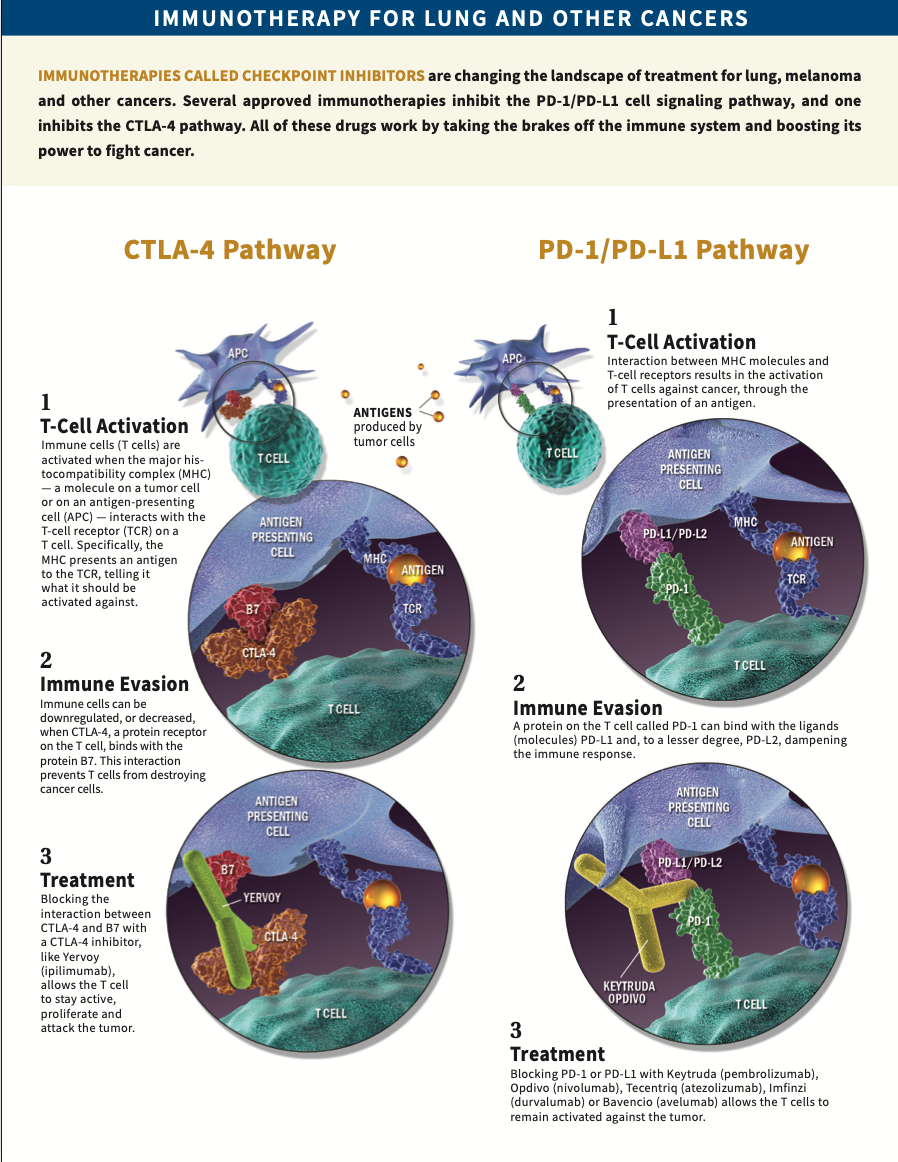Article
Delving Into Immunotherapy
Understanding how the immune system controls itself has led to impressive treatment gains.
Immunotherapy is a rapidly evolving strategy that enlists the body’s own immune system to fight cancer. These treatments work by stimulating the production and activity of T cells and antibodies, which exist naturally in the body and have the ability to recognize and kill cancer cells.
Types of cancer that can be treated with immunotherapies approved by the Food and Drug Administration include melanoma, Hodgkin lymphoma, acute lymphoblastic leukemia, squamous cell carcinoma of the skin, and kidney, bladder, lung, prostate, breast, colorectal, liver, gastric, cervical, uterine, brain, pancreatic, esophageal and head and neck cancers. Immunotherapies are also being tested in other forms of cancer, including additional blood cancers.
Combinations of these drug types with each other, or with other anti-cancer therapies, may be more effective for some patients.
While immunotherapies don't cause the hair loss that comes with chemotherapy, they can spark nausea, rash, fever, chills, fatigue, diarrhea or even severe autoimmune reactions or endocrine hormone deficiencies. These drugs can also be very expensive.
So far, 20% to 30% of patients with immunotherapy-treatable cancers respond, and researchers are asking why, and figuring out how to make the most of the treatments. Some responses can be long-lasting or curative, so there is interest in refining this approach and expanding the number of patients and types of tumors that can be successfully treated.

CYTOKINES
Some cytokines, such as interleukins and interferons, which are found naturally in the body, can also be produced in the laboratory and given to patients to change the way their immune systems are regulated, potentially stimulating immune responses. These approved drugs are used to treat melanoma, kidney and bladder cancers, although they work only in a minority of those patients, and side effects can be severe.
IMMUNE CHECKPOINT INHIBITORS
While T cells have cancer-killing ability, they are normally held somewhat at bay by “inhibitory checkpoints” in the immune system. The job of these checkpoints is to keep the T cells from engaging in out-of- control activity. The problem with this system is that cancers can hide in the body by sending out the same signals as these checkpoints, along the cell-signaling pathways PD-1/PD-L1 or CTLA-4; this way, T cells don’t recognize or fight them.
One group of immunotherapy drugs blocks this kind of signaling so that the checkpoints no longer have a hold over the activity of T cells. This frees up the T cells to fight cancer. However, in doing so, the immune cells also attack some normal tissue, causing a variety of side effects.
Checkpoint inhibitors have been approved for the treatment of a variety of solid tumor types, and continue to be tested in clinical trials. They are also approved to treat any cancer, regardless of type, that is considered microsatellite instability-high, meaning that cancer cells are unable to repair their own DNA when it’s damaged.
MONOCLONAL ANTIBODIES
When the immune system is provoked by foreign cells and other substances, it reacts by activating T-cell lymphocytes (a type of white blood cell), which can directly kill foreign cells, and by stimulating B-cell lymphocytes to make proteins called antibodies. These antibodies are drawn to other proteins known as antigens, which sit perched on the outsides of cells; drawn like magnets, the antibodies attach to the antigens. Once in place, the antibodies call in the immune system to destroy the cells to which they are attached.
Monoclonal antibodies, which are designed to seek and destroy specific cancer-associated antigens, can be made in a lab and then given to patients. Some of these strictly target one type of antigen, but cannot always fight tumors on their own. Bispecific antibodies may be more effective, because they can bind to, and destroy, two different antigens present on one or many cells. One antibody enlists a T cell while the other targets a tumor, bringing the main partners of the immune process together.
ADOPTIVE T-CELL THERAPY
If a good immune response is already happening in a patient’s body, adoptive T-cell therapy may improve it. In adoptive cell transfer, a sample of a patient’s tumor is sent to a lab, where T cells inside the tumor are removed and stimulated to recognize a tumor surface protein and increase in number. Then, this larger group of T cells, known as tumor infiltrating lymphocytes, is returned to the patient intravenously. This experimental method has been shown to induce complete, durable regression of certain malignancies, including a number of blood cancers and melanoma.

CHIMERIC ANTIGEN RECEPTOR THERAPY
Like adoptive T-cell therapy, chimeric antigen receptor (CAR) therapy involves manipulating a patient’s T cells in a lab. But in this case, the T cells are genetically modified to express a specific surface receptor, which prepares them to hone in on, and attack, specific proteins on a particular kind of cancer cell. When the CAR T cells are infused into the patient’s body, they can multiply and continue to eradicate tumors over time. Currently, there are two CAR-T cell therapies approved in the U.S. One is for advanced or recurrent acute lymphoblastic leukemia in children and young adults. The other is for certain types of advanced or recurrent non-Hodgkin lymphoma. Clinical trials have shown that this method can also have significant anti-tumor activity in neuroblastoma and chronic lymphocytic leukemia, and trials are exploring CAR-T cell therapy in an array of solid tumors and blood cancers that affect both children and adults.
CAR-T cell therapy is carried out in the hospital, where patients are monitored closely for side effects, particularly the immune system’s potential attack on healthy organs.

VACCINES
A host of vaccines, some approved and some experimental, also fall into the immunotherapy category. There are four main basic types:
- Vaccines that use an engineered inactivated virus to deliver an agent such as a cytokine that can cause the destruction of cancer cells.
- Vaccines that send whole tumor cells into the body with the goal of drawing the immune system’s attention to the foreign cells so it will fight them — as well as the tumor cells already growing in the body.
- Infused dendritic cell vaccines, which are made uniquely for each patient using his or her own white blood cells, mixed with an agent that will help the body mount an immune response against cancer cells.
- Peptide vaccines. These include a small peptide (amino acid) sequence taken from a tumor-associated antigen. This is mixed with an agent that stimulates dendritic cells to process the peptide sequence; in turn, that causes the immune system to recognize and fight any antigens that contain the sequence.